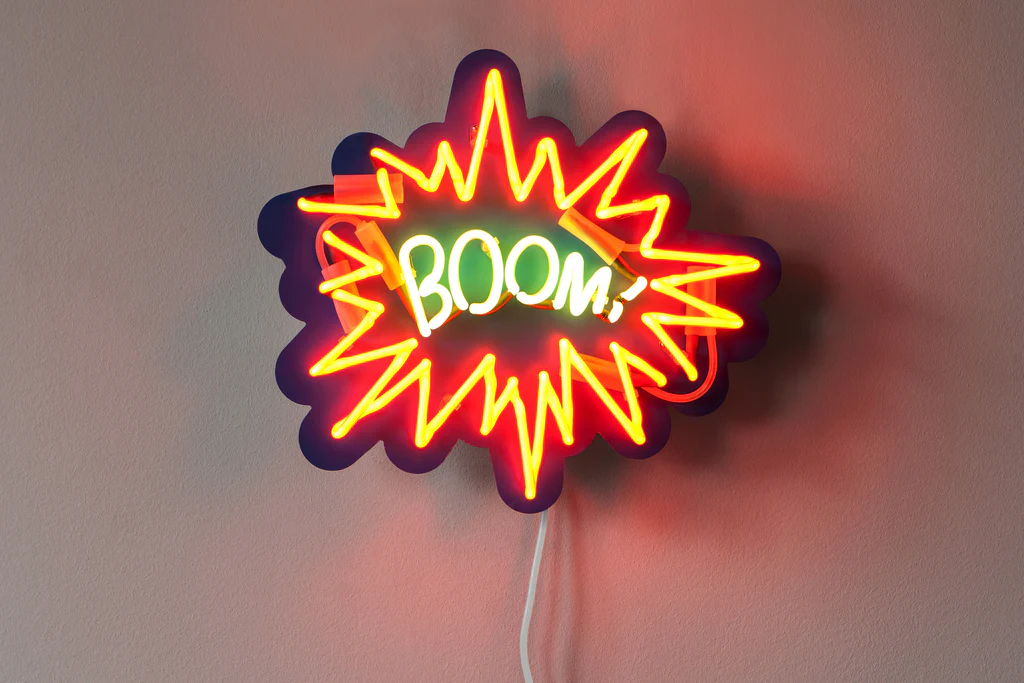Neon & Pop Art: Exploring a misconception
Pop Art, a movement that emerged in Britain and the United States during the 1950s, captivated the world with its bold and vibrant representations of popular culture. While neon signs were not directly employed by Pop artists at the time, there exists an intrinsic connection between neon and Pop Art. This article delves into the historical overview of Pop Art, highlights key Pop artists, explores current artists and brands incorporating neon signs, and discusses the various businesses that could benefit from pop art-inspired neon signs.
photo credit: Vale Arellano/Unsplash
Pop Art emerged during the post-World War II economic boom, an era marked by materialism and consumerism. Unlike other art movements that aimed to criticise these societal changes, Pop Art embraced the omnipresence of commercialism, transforming it into a celebration of itself. Although Pop Art drew inspiration from advertising imagery and language, neon signs were not initially integrated into their artwork.

Roy Lichtenstein, Whaam!, 1963

Andy Warhol, Campbell's Soup Cans, 1962
Neon signs and Pop Art share an indirect connection through their close association with advertising. The advertising industry flourished in the 1950s and 1960s, paralleling the rise of consumerism. This boom in advertising also led to a resurgence in the use of neon, which had first gained popularity in the 1920s but had since been overshadowed. Despite the parallel rise in the use of neon in advertising and the incorporation of advertising imagery in Pop Art, the fusion of the two did not occur until a French artist named Martial Raysse visited New York in the early 1960s.
Raysse, hailing from the French Nouveau Réalisme movement, combined the elements of minimalism and Pop Art to become the only French artist to be associated with the Pop Art movement predominantly confined to the UK and the US. In 1964, he unveiled the first Pop Art neon piece titled "America, America." This groundbreaking artwork connected the language of popular culture with neon, marking a pivotal moment in the integration of neon signs within the realm of Pop Art. Interestingly, "America, America" still holds the record for being the most expensive artwork sold by a living French artist.

Martial Raysse, America America, 1964
Today, the legacy of Pop Art and neon signs continues to captivate artists and brands alike. Numerous contemporary artists draw inspiration from both movements, incorporating neon signs into their artwork to evoke the spirit of Pop Art. These artists skillfully merge the visual impact of neon with the vibrant colours, bold graphics, and iconic symbols synonymous with Pop Art. Through this amalgamation, they create visually striking pieces that pay homage to the enduring influence of Pop Art while embracing the captivating allure of neon.
Moreover, brands have recognized the power of neon signs inspired by Pop Art as a means of enhancing their visual identity and connecting with their target audience. Neon signs offer a dynamic and eye-catching way to showcase a brand's personality, evoke nostalgia, and leave a lasting impression. Businesses in various industries, such as restaurants, bars, clubs, retail stores, art galleries, and entertainment venues, can utilise pop art-inspired neon signs to strengthen their branding efforts. These signs can be used as attention-grabbing storefront displays, distinctive interior decorations, or even as part of interactive installations, creating a visually immersive experience for customers.

photo credit: Jason Leung/Unsplash
In conclusion, while neon signs were not directly utilised by Pop artists during the height of the movement, their connection to advertising and popular culture laid the foundation for their eventual integration into Pop Art. Martial Raysse's "America, America" marked a turning point, forging a path for the fusion of neon and Pop Art. Today, artists and brands continue to embrace this fusion, creating visually stunning artwork and leveraging neon signs inspired by Pop Art to enhance their branding and create memorable experiences. As the influence of Pop Art endures, neon signs serve as a vibrant and captivating medium that perpetuates the spirit of this iconic movement.
photo credit: Zach Key/Unsplash
If you want to know what this can look like, check out our neon Desygns from our series ZAP! inspired by Pop Art and classic comic books in our online shop:



